Panel on Philanthropy’s Role in Estate Planning Offered Options, Inspiration
LONGMEADOW–Wealth manager George C. Keady III has a client who says she has five children: four actual humans, and philanthropy.
“That’s the attitude some people have about giving,” Keady told roughly 20 area residents and staff members of various organizations who gathered on March 30 at Longmeadow Country Club for a panel presentation called “Informed Giving: A Look at Philanthropy’s Role in Estate Planning.”
The talk was offered in partnership by Glenmeadow Retirement and the Community Foundation of Western Massachusetts as part of Glenmeadow’s free education series called Glenmeadow Learning.
Glenmeadow is an accredited not-for-profit continuing care retirement community known for its holistic mission and innovative programs and outreach to the wider community. In opening the panel discussion, Timothy V. Cotz, president and chief executive officer, explained that Glenmeadow’s roots are firmly based in philanthropy; it’s been financial gifts and bequests over the years that have allowed the nonprofit to grow from one that serves 40 people annually to one that serves roughly 475 residents on the Longmeadow campus and throughout greater Springfield.
Cotz said Glenmeadow now gives back to residents in need through scholarship programs, and it provides many free programs in the community, such as Glenmeadow Learning.
The Community Foundation, in its 25th year, is a nonprofit that serves as a steward of philanthropic gifts from community members. Each year, the foundation distributes from $8 to $10 million through grants and scholarship programs that benefit students and nonprofits in Hampden, Hampshire and Franklin counties.
Moderated by Katie Allan Zobel, president of the foundation, five panelists outlined the legal and financial mechanisms through which gifts can be made, discussed the tax benefits of such gifts and also shared their own personal stories of philanthropic inspiration.
Zobel said each year in this country, people offer up over $3 billion in charitable giving, and roughly 80 percent of that is in reaction to an ask. “The majority of Americans are reactive givers,” Zobel said, describing what she calls “check-book giving.” “Many of us don’t stop and think strategically about what we’re trying to accomplish with our gifts.”
Zobel said philanthropy is a great facet of a solid estate plan, and it begins with some planning around what you might want to preserve or change in the world. “What is really most important to you in your life? What are the things that you value most in this world?” she asked.
To help people answer those questions and develop a plan, Zobel recommended the development of a team that includes a financial planner and a tax attorney.
Attorney Todd C. Ratner of Bacon Wilson, P.C. said donor advised funds are one of many charitable giving opportunities. There are many other avenues, some simpler and some more complex.
Some simple means of giving Ratner cited are bequests in wills, revocable trusts and donating appreciated assets, including financial accounts such as IRAs and securities. Other more involved charitable giving opportunities include Charitable Remainder Trusts and Charitable Lead Trusts. These mechanisms, and gifts through real estate, assist the donor in probate avoidance and can also potentially provide the donor with significant income, capital gains and estate tax savings, Ratner said.
By means of example, Keady, of Keady, Foard, Montemagni Wealth Management Group in Springfield, said he and his wife made a gift in stocks to the Community Foundation that provided them with a considerable tax benefit.
Keady said the topic of philanthropy is one that comes up in all his annual reviews with clients. “It’s a broad-based conversation you want to have with an advisor,” he said. “Don’t ever underestimate the type of impact you can make.”
Panelist David Starr, who has worked for Advance Publications—the owners of media organizations such as The Republican, locally—for over 75 years, said he and his wife, Peggy, began giving to local nonprofits in earnest in the late 1970s.
He said that through a more recent, $1 million gift to the Community Foundation, they also established endowment funds for the Springfield Museums, WFCR, Springfield Symphony and WGBY.
“We wanted to make sure they’d live on after we didn’t,” Starr said. “We gave it while we were still alive, and while they all needed the funds.”
Panelist John Gallup said he and his wife, Paula, created a charitable remainder trust through the foundation, through which they made a substantial gift that benefits members of the community, and they also continue to earn quarterly and annual payments on their funds.
“I can’t tell you how rewarding it’s been to create this situation,” he said.
To learn more about Glenmeadow and its history and offerings, visit www.glenmeadow.org.
To learn more about the Community Foundation, visit www.communityfoundation.org.
About Glenmeadow
In the 1800s, elderly individuals without family or means were sent to live at what was called “the poor farm.” In 1884, a group of civic leaders raised funds among themselves and other area families and purchased a house on Main Street in Springfield’s south end. Quickly outgrowing that house, land was purchased on the corner of Chestnut and Carew streets, where a new home was constructed and opened in 1900. In 1960, the name was changed to Chestnut Knoll, and in 1992, it began to admit men.
In 1993, the organization purchased a 23-acre parcel in Longmeadow to build a new community that would provide both independent living and assisted living in one building with various common areas. This was a new concept known as a continuing care retirement community. Existing residents from the old Chestnut Knoll property were moved to the new campus in 1997. Shortly after the move, the board voted to change its legal name to Glenmeadow to coincide with the name being used by the developer of the property.




